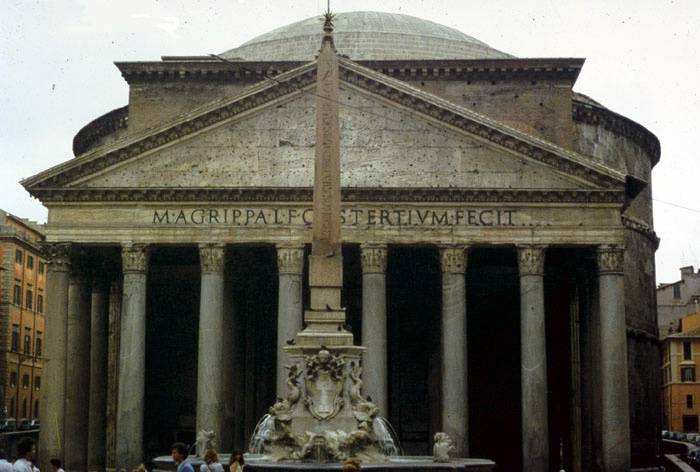|
|
 |
|
The Pantheon |
|
written
by zinnia / 09.04.2005 |
|
|
| |
Introduction |
| |
| |

|
| http://harpy.uccs.edu/roman/html/hadrian2.html |
| The Pantheon |
| The building with its remarkable design and influential status, was one of the first temples to be converted to a church. |
| |
|
Standing in the Campus Martius, the Pantheon remains to date as the single intact edifice that has come down to us from the Greco-Roman period; it is also the only such temple that has been in continuous use up to our present time. Prior to being the rotunda as we see now, the Pantheon was originally a rectangular structure facing south, built during the Roman Republic by Marcus Vipsanius Agrippa in 27 B.C.E. The temple was dedicated in particular to patrons of Caesar and Augustus (Julio-Claudian family), Mars and Venus. It was burned in a great fire in 80 C.E. and reinstated by Emperor Domitian. Thirty years later in 110 C.E., the temple was struck by lightning and flamed to the ground. It was during Hadrian’s reign (117-38 C.E.) that the Pantheon was completely reconstructed to its current form. The emperor intended this sanctuary to “reproduce the likeness of the terrestrial globe and of the stellar sphere” with the open cupola as center so “prayers would rise like smoke toward that void where we place the gods”.
Roman masonry dome culminated with the Pantheon. Designed by an architect unknown in 120 C.E., the Pantheon is composed of three components: a colonnaded pronaos (entrance portico) – facing north – that reminisces the front of a customary Greek temple, an intermediate junction connecting it to the last element, and the close domed rotunda with an oculus admitting the only light. On the proch’s entablature bears the inscription M•AGRIPPA•L•F•COS•TERTIVM•FECIT in bronze letters, which Hadrian copied from Agrippa’s Pantheon. It translates to “Marcus Agrippa, son of Lucius, consul for the third time, built this”. This common practice by Hadrian – to omit the use of his own name on buildings he’d commissioned, was done in similar reconstruction projects throughout Rome – caused great confusion in determining the time range of Pantheon’s construction. The issue was resolved by epigraphers (1892) through studying tile-shaped bricks from the building. These ancient Roman bricks were systematically stamped with information regarding brickyard, current consul and the like in abbreviated Latin. As it turns out the majority of the Pantheon’s brick stamps are of the early 120s.
After a final renovation by Septimius Severus in 202 C.E., the Pantheon persevered through four centuries of flux and neglect. Despite the capital’s move to Constantinople and flooding from the Tiber river, the Pantheon remained intact while countless buildings nearby fell to rubble. In 609 C.E., Byzantine emperor Phocas gave it to Pope Boniface IV. The building was consecrated and converted to a church dedicated to Mary and All Saints. In the early 1600s, Pope Urban VIII stripped and melted ~200 tons of bronze roof trusses from the porch roof for fortification use in Castel Sant’Angelo. According to the Pope, the metal was far better used to “defend the Holy See than to keep the rain out of the Pantheon porch”. This act led to the quip “quod non fecerunt barbari, fecerunt Barberini” which translated means “what the barbarians did not do, the Barberinis [Urban VIII’s family name] did”.
More recently, the Pantheon was used as a tomb. The famous artist Raphael was buried in the rotunda in 1520; in 1878, King Vittorio Emmanuele II of United Italy in the great west niche; and King Umberto I in 1900.
|
| |
|
| |
|
|
 |
|

